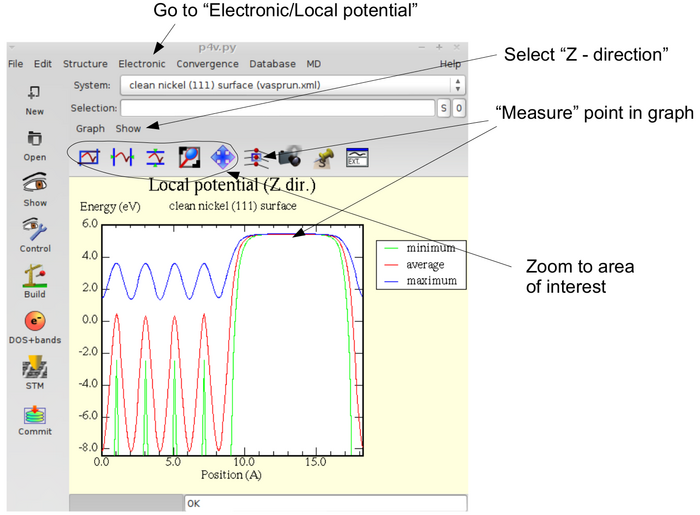Ni 111 surface high precision: Difference between revisions
No edit summary |
Vaspmaster (talk | contribs) |
||
| Line 79: | Line 79: | ||
*Use p4vasp to show the planar average of the potential: | *Use p4vasp to show the planar average of the potential: | ||
[[File:Fig Ni 111 high prec 1.png|700px]] | [[File:Fig Ni 111 high prec 1.png|700px]] | ||
<!-- | |||
*The plot of the planar average of the potential for this example should look like the following: | *The plot of the planar average of the potential for this example should look like the following: | ||
[[File:Fig Ni 111 high prec 2.png|200px]] | [[File:Fig Ni 111 high prec 2.png|200px]] | ||
--> | |||
*Vacuum potential <math>E^{\mathrm{vac}} = 5.45</math> eV. | *Vacuum potential <math>E^{\mathrm{vac}} = 5.45</math> eV. | ||
*Fermi level <math>\epsilon_{\mathrm{F}} = 0.224</math> eV. (from {{TAG|OUTCAR}} file). | *Fermi level <math>\epsilon_{\mathrm{F}} = 0.224</math> eV. (from {{TAG|OUTCAR}} file). | ||
Revision as of 18:48, 23 June 2019
Overview > Ni 100 surface relaxation > Ni 100 surface DOS > Ni 100 surface bandstructure > Ni 111 surface relaxation > CO on Ni 111 surface > Ni 111 surface high precision > partial DOS of CO on Ni 111 surface > vibrational frequencies of CO on Ni 111 surface > STM of graphite > STM of graphene > collective jumps of a Pt adatom on fcc-Pt (001): Nudged Elastic Band Calculation > List of tutorials
Task
Calculation of the adsorption energies and the work function of a Ni (111) surface with high precision.
Input
POSCAR
fcc (111) surface
3.53000000000000
0.7071067800000000 0.0000000000000000 0.0000000000000000
-0.3535533900000000 0.6123724000000000 0.0000000000000000
0.0000000000000000 0.0000000000000000 5.1961523999999999
Ni
5
Selective dynamics
Direct
0.0000000000000000 0.0000000000000000 0.0000000000000000 F F F
0.3333333300000021 0.6666666699999979 0.1111111100000031 F F F
0.6666666699999979 0.3333333300000021 0.2222222199999990 F F F
-0.0000000000000000 -0.0000000000000000 0.3320935940210170 T T T
0.3333333300000021 0.6666666699999979 0.4413539967541983 T T T
0.00000000E+00 0.00000000E+00 0.00000000E+00
0.00000000E+00 0.00000000E+00 0.00000000E+00
0.00000000E+00 0.00000000E+00 0.00000000E+00
0.00000000E+00 0.00000000E+00 0.00000000E+00
0.00000000E+00 0.00000000E+00 0.00000000E+00
INCAR
ENMAX = 400 general: SYSTEM = clean nickel (111) surface ISTART = 0 ICHARG = 2 ISMEAR = 2 ; SIGMA = 0.2 ALGO = Fast EDIFF = 1E-6 special: LVHAR = .TRUE. # LVTOT = .TRUE.
- Run a single point calculation for the Ni(111) clean surface at a higher cutoff (400eV), which is needed to compute the adsorption energy.
- Potentials for O and C require an energy cut-off of 400eV:
- Previous calculation for clean cannot be used as reference.
- Recalculate with same energy cut-off.
KPOINTS
K-Points 0 Monkhorst-Pack 9 9 1 0 0 0
Calculation
Adsorption energies
- Change of cut-off lowers total energy:
- -25.732 eV (270 eV); -25.737 eV (400 eV).
- Becomes more important for larger cells.
- The adsorption energy is calculated in the following way:
- [math]\displaystyle{ E_{\mathrm{ads}} = E_{\mathrm{total}} - E_{\mathrm{clean}} - E_{\mathrm{CO}} }[/math].
- [math]\displaystyle{ E_{\mathrm{ads}} = -40.829 + 25.737 + 14.835 = -0.257 }[/math] eV.
Work function
- We use this run also to calculate the work-function of Ni(111).
- Use p4vasp to show the planar average of the potential:
- Vacuum potential [math]\displaystyle{ E^{\mathrm{vac}} = 5.45 }[/math] eV.
- Fermi level [math]\displaystyle{ \epsilon_{\mathrm{F}} = 0.224 }[/math] eV. (from OUTCAR file).
- Work function [math]\displaystyle{ \Phi = E^{\mathrm{vac}} - \epsilon_{\mathrm{F}} = 5.23 }[/math] eV.
Download
Overview > Ni 100 surface relaxation > Ni 100 surface DOS > Ni 100 surface bandstructure > Ni 111 surface relaxation > CO on Ni 111 surface > Ni 111 surface high precision > partial DOS of CO on Ni 111 surface > vibrational frequencies of CO on Ni 111 surface > STM of graphite > STM of graphene > collective jumps of a Pt adatom on fcc-Pt (001): Nudged Elastic Band Calculation > List of tutorials
Back to the main page.

